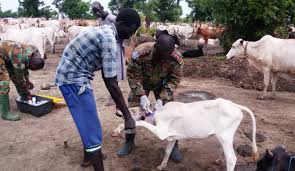What is routine livestock rearing? A routine is a fixed or regular way of doing something. However, in livestock rearing, there are practices that are done repeatedly after a certain period of time. These practices include:
Feeding in livestock rearing
Livestock feeding is very important since it affects the animal’s productivity. Therefore, specialized feeding is required at certain periods. Such periods include:
Flushing
Flushing is the period when a high plane of nutrition is given to the animal around service time. The amount of food given is increased both in quality and quantity. It is extremely important, especially in most ruminants such as sheep.
Importance of Flushing
- Facilitates implantation of the zygote.
- Increases conception rate.
- In sheep, it increases the lambing percentage.
Steaming up
Steaming up is where you provide an extra feed of high nutritive value to an animal during the last weeks of gestation.
Importance of steaming-up
- Promotes good health of the mother.
- Ensures the birth of a healthy animal.
- Helps in building up energy for parturition.
- Helps in Maintaining high milk yield after birth.
Parasite and disease control in livestock rearing

There are many ways of controlling parasites and diseases on a routine basis. It can be done through the following practices:
- Who is Paolo Macchiarini, age, family, children, Imprisonment?
- Bruce Bilson age, early life, education, wife, children, career.
- Who Is Chris Hemsworth? origin, and love life.
- Olivia Flowers Bio-Southern Charm, Children, Age, Husband.
- Jim Gardner Bio-Age, Edu, Wife, Children, and Career.
- John Legend age, family, wife, children, fame, net worth.
- Craig Stevens bio, wiki, age, children, wife, net worth, career.
Vaccination- It is active immunization by the use of vaccines. Vaccines can be administered in the following ways:
- By injections.
- Orally through the mouth.
- By inhalation through the nose.
- Through the cloaca.
However, there are various vaccines depending on the type of disease organisms and they are grouped as follows:
- Live virulent vaccines.
- Live Attenuated vaccines.
- Dead vaccines.
- Toxins
Properties of a Good Vaccine.
- Should be easy to administer to the animal.
- Should have no side effects when inoculated.
- A single dose should produce lifelong immunity.
- Also, the immunity it produces should be good as natural immunity.
Hoof trimming in livestock rearing
So, hoof trimming is the cutting back of overgrown hooves. Overgrown hooves encourage the accumulation of dung and dry feeds in the folds which contribute to bleeding of hooves and rotting of the skin.
Reasons for hoof trimming
- To facilitate easy movement.
- Control foot rots disease.
- Breeding practices.
Therefore, they are carried out to enhance successful breeding in animals. Such practices include:
- Crutching and Ringing.
- Tupping and Serving.
- Raddling.
- Egerton university, fees, location, courses.
- What is the history of Kenyatta University?
- Kenya Institute of special education, courses.
- The best private primary schools in Nyeri county.
- A list of special secondary schools, and contacts.
- Mount Kenya University history, fees, courses
- List of Accredited Private Universities in Kenya